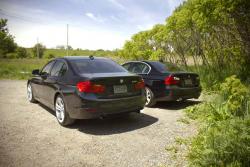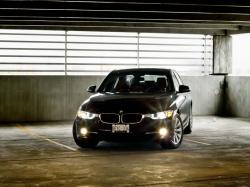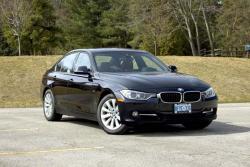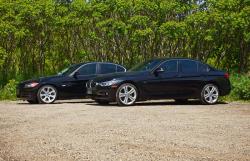 2013 BMW 335i vs 2008 BMW 335i. Click image to enlarge |
Review and Photos by Jeff Wilson
If you’re an automotive geek like most of us at Autos.ca, you probably refer to most German cars by their generational internal reference codes given by the manufacturers rather than the marketing names.
For instance, the 993 is the last of the air-cooled Porsche 911s. The B8 generation Audi S4 replaced the V8 with a supercharged V6. And of course everybody knows that the now classic W126 (S-Class) Mercedes was built like a tank. You get the idea.
This exceptionally advanced part of the car nerd’s brain enables him (or her) to show off the considerable time that must’ve been wasted learning all the codes, but also facilitates easier discussion with other car nerds.
BMW 3 Series aficionados toss around the marque’s development codes like a Trekkie speaks Klingon, and so for those who are uninitiated, let me give you a brief overview of the codes as they relate to our comparison; mostly to show off how learned I am, but also to help clarify for the review.
Our subject vehicles are BMW’s enduring and revered compact luxury sedans: the 3 Series. The current generation (2012–present) sedan is known as the F30. The previous generation (2006–2011, in Canada) sedan is known as the E90. The E92 is the coupe, E93 the convertible and E91 the wagon.
The media and Internet “experts” alike have wailed incessantly that the F30 3 Series is too big, too soft and too aloof compared to its predecessors, and that they’ve lost much of the passionate soul for which this line has become famous. Cries of BMW losing its way and abandoning the faithful, performance-hungry customers that have lusted after and purchased the nimble, high performance sedans for more than three decades are echoing through online forums around the world. Are these witch hunts founded? Let’s find out.
   2013 BMW 335i vs 2008 BMW 335i. Click image to enlarge |
Our current generation car is a black 335i. BMW Canada kindly provided us a 335i Sport with xDrive all-wheel drive and an eight-speed automatic – the most popular configuration for a new 335i, by the way. But our E90, also in black, is a 2008 335i with Sport Package, rear-wheel drive and a proper row-your-own six-speed manual. So the comparison isn’t really fair, which is why we also sought out an additional F30 335i Sport with a manual and rear-wheel drive.
Full disclosure, the E90 car is my personal daily driver and my third 3 Series BMW. It was purchased a few years ago as a Certified Pre-Owned car from a BMW dealership ensuring it had gone through BMW’s rigorous inspection before being sold and came with the all-important warranty to 160,000 km (or six years). Now approaching its six-year birthday, my car, with only 75,000 km on it, will run out of time long before warranty mileage.
When BMW revealed the E90 to the world in ’05, there was a collective gasp of relief that the Bangle-era styling exercise was a relatively tame application for the new 3 Series. That said, the E90 was still larger, heavier and more overtly styled than its predecessor, but most agreed that it still retained much of the BMW DNA as a legitimate sport sedan.
In 2007, the 335i was introduced with a twin-turbo version of the venerable 3.0L inline-six-cylinder engine, dubbed the N54 (more nerd codes for you). This engine, with its prairie-flat torque curve, feels much stronger than its 300 hp/300 lb-ft rating suggests.
Early N54-equipped cars tended to heat up under very brisk driving exercises and BMW quickly added an oil-cooler fix. Other well-documented problems for the N54 include faulty high-pressure fuel pumps and turbos that can be consumed at alarming rates. Fortunately my car has been relatively reliable so far, knock on wood.
For the 2011 model year, the N55 engine replaced the N54 and featured a single twin-scroll turbo instead of the twin-turbo configuration of the older mill. This resulted in fewer moving parts (and thus, arguably better reliability) and improved fuel consumption and emissions. Power and torque output remains the same, although peaks for each are delivered around 100 rpm lower in the newer engine. The N55 carries on into the F30 335i as found in our test cars.
Now that we’ve addressed all the techno mumbo-jumbo, what are these cars actually like to drive? Succinctly, both old and new, they’re fantastic.











